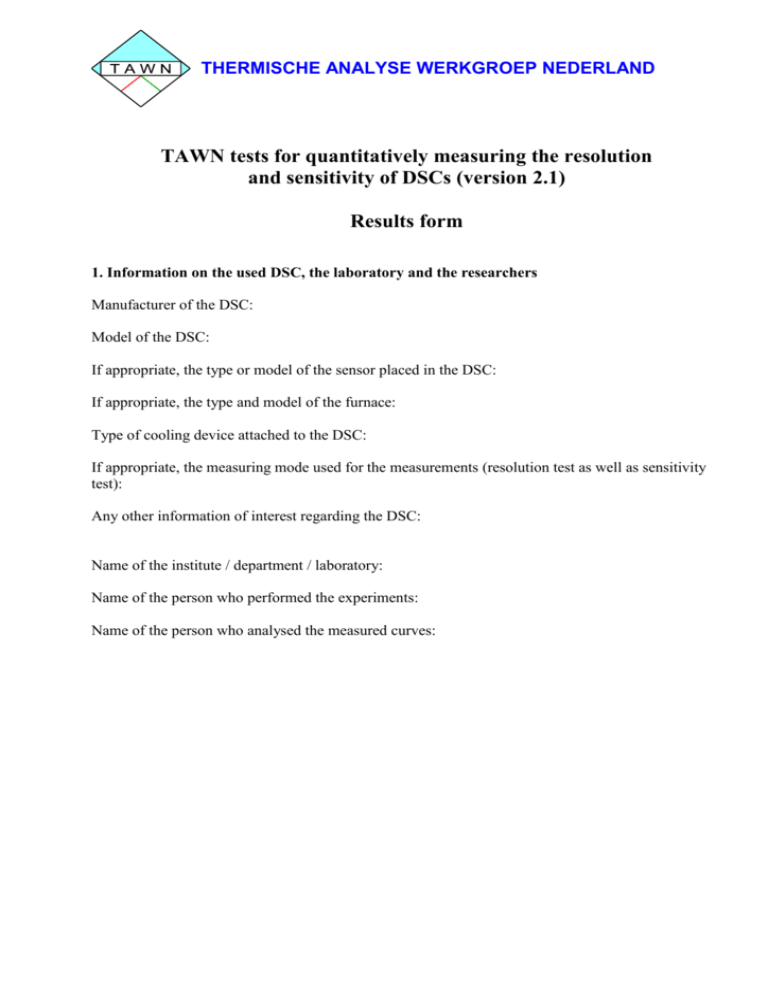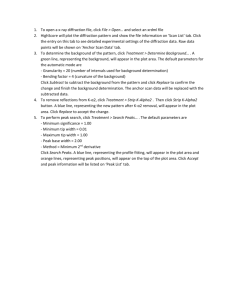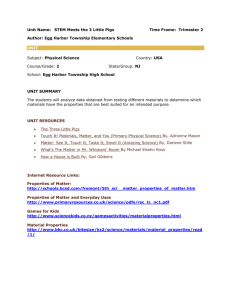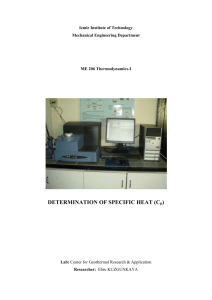TAWN DSC Test 2.1
advertisement

THERMISCHE ANALYSE WERKGROEP NEDERLAND TAWN tests for quantitatively measuring the resolution and sensitivity of DSCs (version 2.1) Results form 1. Information on the used DSC, the laboratory and the researchers Manufacturer of the DSC: Model of the DSC: If appropriate, the type or model of the sensor placed in the DSC: If appropriate, the type and model of the furnace: Type of cooling device attached to the DSC: If appropriate, the measuring mode used for the measurements (resolution test as well as sensitivity test): Any other information of interest regarding the DSC: Name of the institute / department / laboratory: Name of the person who performed the experiments: Name of the person who analysed the measured curves: THERMISCHE ANALYSE WERKGROEP NEDERLAND 2. Resolution test Crucibles: manufacturer, type and material: mass of the reference crucible: mass of the empty sample crucible (incl. lid): Sample: is this sample supplied by the TAWN? describe the sample substance as accurate as possible, i.e. supplier, purity, etc.: yes / No sample mass: Purge gas: type: flow rate: Temperature program: Sampling rate: Confirm that the temperature was exactly programmed as described in section 2.1 of the protocol Yes / No. (i.e. 1) Isothermal at 100 °C (373 K) for 1 min; 2) Cool from 100 °C to 25 °C (373 K - 298 K) at a cooling rate of 10 K/min; 3) Isothermal at 25 °C (298 K) for 1 min; 4) Heat from 25 °C to 100 °C (298 K - 373 K) at a heating rate of 5 K/min.) If no, indicate any differences: Were additional measurements performed at other heating rates? Yes / No. If yes, confirm that the temperature program was expanded with 6 additional series of the above mentioned 4 steps, but now with different heating rates in each 4th step, in the order: 10 K/min; 40 K/min; 1 K/min; 20 K/min; 3 K/min; and 5 K/min? Yes / No. If no, indicate any discrepancies: Analysis of the results: Perform the following actions on the DSC-curve recorded during heating at a rate of 5 K/min. When other heating rates were also used, repeat all actions for each heating rate. Plot DSC-curves as described in section 2.2 of the protocol (i.e. a plot of heat flow versus temperature and a plot of heat flow versus time). Add the plots as appendices to this results form. Give the extrapolated onset temperatures (Te) of both (in most cases not completely separated) peaks. And for the double peak, give the total enthalpy of transition (trH) evaluated from the observed curve. Peak Te trH Low-temperature peak enter value High-temperature peak enter value Double peak enter value Which plot did you use for evaluating the extrapolated onset temperatures: - heat flow versus temperature Yes / No; - heat flow versus time Yes / No. Which plot did you use for evaluating the total heat of transition: - heat flow versus temperature Yes / No; THERMISCHE ANALYSE WERKGROEP NEDERLAND - heat flow versus time Yes / No. From the plot of the heat flow versus time, give the peak height and the valley value measured as described in section 2.2 of the protocol. Calculate the resolution of the DSC as the peak height divided by the valley level. Peak height: enter value Valley level: enter value Resolution: enter value THERMISCHE ANALYSE WERKGROEP NEDERLAND 3. Sensitivity test Crucibles: manufacturer, type and material: mass of the reference crucible: mass of the empty sample crucible (incl. lid): Sample: describe the sample substance as accurate as possible, i.e. supplier, purity, etc.): sample mass: Purge gas: type: flow rate: Temperature program: Sampling rate: Confirm that the temperature was exactly programmed as described in section 3.1 of the protocol: Yes / No. (i.e. 1) Isothermal at 130 °C (403 K) for 5 min; 2) Heat from 130 °C to 140 °C (403 K - 413 K) at a heating rate of 0.1 K/min. If no, indicate any differences. Was the additional cooling curve also recorded and programmed as described? Yes / No. If yes, confirm that the temperature was programmed as described? Yes / No. (i.e. was the temperature program expanded with the third step: 3) Cool from 140 °C to 130 °C (413 K - 403 K) at a cooling rate of 0.1 K/min.) If no, indicate any discrepancies: Analysis of the results: The raw data must be presented and analysed, without any data manipulation, like smoothing or deconvolution. If one wants, manipulated results can also be presented and analysed, but always in addition to the raw date. This allows to observe the effect of the data manipulation. Since the resolution and sensitivity of a DSC are not independent, perform exactly the same manipulation procedures on both the resolution test and the sensitivity test. Plot the DSC-curves that were recorded during the second and, if appropriate, third step of the temperature program. The horizontal axis of both plots should display the temperature, the vertical axis should display the heat flow. An endothermic and exothermic peak should be present in the heating and cooling curve, respectively. These curves are used for the evaluations. As additional information, please also plot the DSC-curves as a function of time. Add the plots as appendices to this results form. For each peak, give the extrapolated onset temperature (Te) and the enthalpy of transition (trH) evaluated from the observed peaks: Heating / Cooling Te trH Heating enter value enter value Cooling enter value enter value Measure the top-to-top noise level and the peak height as described in section 3.2 of the protocol. Calculate the sensitivity as the peak height divided by the top-to-top noise level. Heating / Cooling Heating Cooling Top-to-top noise level enter value enter value Peak height enter value enter value Sensitivity enter value enter value THERMISCHE ANALYSE WERKGROEP NEDERLAND




